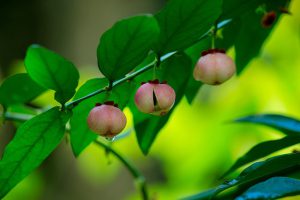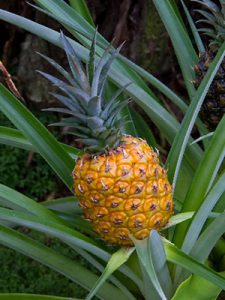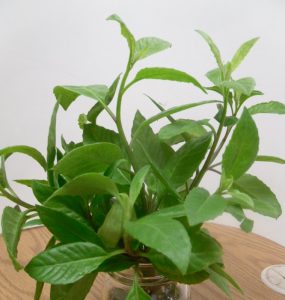The things we grow ourselves taste the best. Whether it be the measly little tomatoes that cling to the weedy vine that grew out of the compost heap or the slightly holey greens that grow along the garden edges. The flavor of perfectly sun-drenched red ripeness hidden in opportunistic ruby tomatoes is unlike any other. The plucking off the vine engages the sense of touch, and the smell that emanates from both vine and fruit enraptures the experience, encapsulated in memory for us to relish later. The taste and texture as we consume them are unparalleled and forces us to close our eyes to fully engage in the absolute beauty of nature’s bounty. These prescient moments in life are rare, as modern distractions can call us from the experience of living things that surround us and the processes that go into their life cycles.
Growing and consuming plants from our gardens offers a connection to nature and the opportunity to be present in the eternity of a moment. It is a rare occurrence that we get to eat something that is allowed to reach the pinnacle of ripeness while still being connected to the earth or its mother plant. Many of the vegetables and fruits we consume are picked early to help prepare them for the long journey to our stores and homes many miles away from the fields they are grown in. However, there are opportunities to experience this all around our landscapes and communities. Nurturing edible plants in our landscapes draws us to these memories and creates new ones. Observation of the processes of these plants can connect us to the natural environment by enlivening our attention to the methodical beauty of creation, the rapture of pinnacle perfection, and the graceful attenuation of life and living things. These ebbs and flows mark the rhythms of existence and allow us to appreciate the gift of our own lived experience. In this series of articles, we are exploring some of this sensory engagement with nature by examining ornamental edible plants that can be used throughout our landscapes. These plants can beautify our landscapes, engage our senses, and fill our plates with abundance.
In each of the three articles, we are describing plants with a variety of complexity of form and character, plants whose traits can enhance and beautify, while offering nourishment. Plants may be shrub-like, vining, rhizomes, trees, or groundcover able to grow in a variety of soil, light, and moisture.

Katuk (Sauropus androgynus): This small perennial shrub with dappled leaves of soft green and cream thrives in partial shade to full sun. The form and structure of the plant are balanced and pleasing to the eye and work as a low hedge or canvass backdrop to build texture in the landscape. The dynamic aesthetic of katuk also endears it to the design sense as its leaves dance in gentle breezes and little drooping flowers are a closely discovered fascination. Although frost sensitivity limits the climatic range of this plant it can exist in warm corners and microclimates in some Central Florida locations but is unlikely to survive in more northern Florida landscapes.
This little shrub grows up to 6’ and its foliage density is encouraged by snapping green new growth, pinching back to encourage leafing. The edible leaves of Katuk are nutty in flavor and can be eaten fresh, stir-fried, and in soups. The health benefits are numerous as katuk is high in protein and contains vitamins A, B, C, and Fe, and Ca. The delicate little drooping flowers can also be added to soups or cooked with other vegetables. One word of caution is that overconsumption of fresh katuk has been shown to have some negative effects due to the heavy metal content of the plant.

Pineapple (Ananas comosus): This herbaceous perennial foliage plant thrives in full sun, is drought tolerant and despite its bristly demeanor produces a weighty fruit. A prize of golden tart sweetness, the biting into of cold delight on a summer day, won free from the guardian spines of this prickly bromeliad. Closely related to Spanish moss, and like other bromeliads, Pineapple can tolerate a range of soil conditions but does best in a loamy well-draining soil. Pineapple can provide textural interest when mixed among common landscape plants. Most specimens reach between 3 and 6 feet in overall height and spread and mingle well with other plants of similar needs. Several bespoke varieties of pineapple exist to add a pleasing array of colors to your plate, with the ‘Red Spanish’ producing squarish pale-yellow fruit and ‘Sugarloaf’ with white flesh and massive 6 lb. fruits.
In an amazing feat of reproductive prowess, the Pineapple can produce a new plant directly on top of the fruit as well as on the stem, as suckers (or pups), and from underground stem portions. Fruit of the Pineapple is best when harvested at a fully golden stage when the tartness and sweetness are in jubilant balance. A reliable source of vitamins A and C as well as Potassium, eaten grilled, fresh, made into jams, salsa, marinades, and chutneys, or eaten in an upside-down cake, the Pineapple is a perennial crowd-pleaser.

Longevity Spinach (Gynura procumbens)- This perennial leafy green groundcover native to China Southeast Asia and Africa that thrives in shade to full sun. The light green slightly serrated pinnate leaves along the fleshy soft stems meander through the garden carefully without intrusion. Longevity spinach is extremely easy to care for, as maintenance and propagation are a breeze. The soft stems are easily cut and can be dropped in a vase of water on the counter where one can both pick the leaves off for inclusion in a recipe while the cuttings distribute filamentous roots in the water and last up to a couple of weeks. Following this the rooted cuttings can be planted in the garden. The plant is quite hearty but cannot handle cold temperatures and may die back to the ground in a freeze.
Longevity spinach carries the name due to the perceived health benefits and traditional medicinal uses. Research on the use of longevity spinach suggests that there is some truth to this as the plant can help with hypertension, reduce inflammation, and has many minerals and vitamins that contribute to a healthy diet. The beauty of using longevity spinach is that it is incredibly diverse and can be eaten raw or cooked. It is a wonderful green addition to smoothies, soups, pasta dishes, casseroles, and omelets. The taste of longevity spinach is mild and fresh leaves are crisp and mildly mucilaginous.

Jujube (Zizyphus jujuba)- Jujube or Chinese Date is a small to medium fruit tree that grows 15-35 feet tall. Providing a dappled shade with wonderfully expressive limbs, single or multi-trunked, reaching out in multiple directions. The elliptical to ovate, light to dark green leaves are emotive and dance softly in even the lightest breeze. The shaggy bark and dramatic limbs are statuesque, draping limbs of shaggy gray in tiered fluttering. Jujubes are drought tolerant, can handle full sun to part shade, and can be planted as the pinnacle in a tiered landscape structure or under larger tree species if scale and space permit. This tree has a wide climatic range, allowing it to be planted as far north as Oregon, and is broadly variable in its desired soil types.
The fruits are small, round or oblong, starting green and bronzing to a fine mahogany when ripe. The flavor is best described as a sweet mix of cherry, apple, and date. Canned, dried, jammed, or fresh, the fruits provide Potassium, Calcium, Magnesium, and Vitamins A and C and are a source of valuable antioxidants.
 3
3
